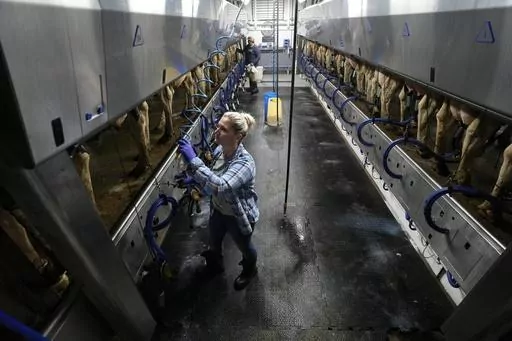Unlock better milk protein production with optimized amino acid absorption. Is your dairy herd missing out?
Summary: The relationship between milk protein production, absorbed amino acids (AA), and digested energy (DE) in dairy cattle is pivotal for boosting farm profits. Past methods focusing on a single limiting nutrient fell short. Recent findings show that considering multiple nutrients gives a more accurate picture. Key AAs like His, Ile, Lys, Met, and Thr have a consistent impact on milk protein at different intake levels. However, expressing EEAs as ratios is problematic as it distorts linear regression assumptions. The study recommends using models that integrate independent and additive nutrients, challenging the old single-nutrient approach. This holistic view leads to better milk protein production predictions, vital for efficient and profitable dairy farming.
- Prior single-nutrient methods for predicting milk protein production in dairy cattle have proven inaccurate.
- Considering multiple nutrients provides a more precise prediction of milk protein production.
- Essential amino acids (AAs) like His, Ile, Lys, Met, and Thr consistently impact milk protein yield.
- Using ratios of absorbed EAA to other parameters distorts linear regression assumptions and is not recommended.
- Integrating independent and additive nutrients into models offers superior accuracy over single-nutrient approaches.
- This holistic approach enhances the efficiency and profitability of dairy farming.

Are you optimizing your herd’s milk production? Could your herd’s nutrition affect milk protein yield? Understanding the complex interplay between milk protein synthesis and amino acid absorption may significantly boost your dairy operation’s efficiency and profitability. “Milk protein production is the largest draw on amino acid supplies for lactating dairy cattle.” This relationship demonstrates how every aspect of your herd’s nutrition may affect your bottom line. Are you providing them with a healthy diet that promotes protein synthesis? This article digs into revolutionary findings from a thorough meta-analysis, giving concrete advice to help you take your dairy farming to the next level.
The Hidden Nutritional Factors That Supercharge Milk Protein Production
Milk protein synthesis in dairy cattle revolves around the mammary glands’ capacity to synthesize and produce milk, which relies mainly on the supply and use of amino acids (AAs) and energy. AAs are the building blocks of proteins, such as caseins and whey, which are absorbed via the intestinal walls and delivered to the mammary glands.
Energy is complementary, powering the metabolic processes that promote protein synthesis. The interaction between digested energy (DE) and AAs is critical—energy intake increases AA usage efficiency, which affects AA conversion into milk protein. Historically, methods for estimating milk protein synthesis focused on milk volume, which resulted in mistakes when employing the first-limiting nutrient idea.
More advanced models, including several AAs and energy sources, have evolved to predict milk protein production better. Newer models acknowledge numerous additive and independent impacts of various nutrients, moving away from the single-limiting nutrient paradigm and reflecting the complex biological interactions inside the dairy cow’s body.
Revolutionizing Milk Protein Predictions: A Multi-Nutrient Approach Leads to Superior Accuracy
The meta-analysis findings, published in The Journal of Dairy Science, demonstrated considerable increases in forecasting milk protein synthesis by including absorbed amino acids (EAA) and digested energy (DE) into the models. The new models outperformed the classic first-limiting nutrient method, with a root mean squared error (RMSE) of over 21%. Considering numerous amino acids and energy sources, the RMSE was dramatically lowered to 14%-15%. This remarkable increase highlights the relevance of a multimodal approach to nutrition modeling in dairy cattle, which improves accuracy and precision.
Understanding the Role of Digested Energy in Milk Protein Production
So, let’s speak about energy and how it affects milk protein production. When cows consume, the power in their diet is broken down and utilized to produce milk protein. This energy is derived from digested energy (DE). Think about DE as the fuel that cows need to create milk.
Now, DE isn’t just one thing; it comprises different parts. Each part plays its role in boosting milk protein:
- Starch: This is similar to a rapid energy source. It is quickly digestible and provides cows with a quick energy source, allowing them to produce more milk protein.
- NDF (Neutral Detergent Fiber): This portion aids in digestion. It degrades more slowly than starch, resulting in a consistent energy flow, but it is only half as efficient as starch in increasing milk protein.
- Fatty Acids: These resemble a thick energy packet. They pack a lot of energy into a compact area, giving cows a significant surge and increasing milk protein.
- Residual OM (Organic Matter): Everything digested comes under this category. It functions similarly to NDF, providing consistent energy and aiding milk protein synthesis.
Cows may produce milk protein more effectively when they get a balanced mix of these varied energy sources. It’s like providing them with the necessary fuel to continue producing high-quality milk!
Essential Amino Acids (EAA) and Their Impact:
When it comes to milk protein synthesis, essential amino acids (EAAs), including histidine (His), isoleucine (Ile), lysine (Lys), methionine (Met), threonine (Thr), and leucine (Leu), play critical roles. Each amino acid contributes specifically to milk protein synthesis, making its presence in the cow’s diet essential.
Histidine is well-known for its involvement in hemoglobin construction, but it also considerably impacts milk protein synthesis. Isoleucine and leucine are essential for muscle protein synthesis and energy supply to the mammary gland. Lysine is often the first limiting amino acid in dairy cow diets, affecting milk output and protein content. Methionine is a methyl group donor, essential for metabolic activities and protein synthesis. Threonine is necessary for immunological function and gut integrity, which indirectly affects milk production.
The new models anticipate milk protein response plateaus for these amino acids, which is significant for diet design. For example, the plateau for absorbed histidine, isoleucine, and lysine is roughly 320 g/d, while methionine is 550 g/d. Threonine levels plateau at about 395 g/d.
Why is this important? Identifying these response plateaus ensures that diets satisfy but do not exceed the needs of these EAAs, maximizing both cow health and milk production efficiency. Excessive or inadequate amino acid consumption might cause metabolic inefficiencies, affecting milk supply and composition. This deep knowledge enables farmers to fine-tune diets for optimal milk protein content and output.
Boost Your Bottom Line: The Untapped Potential of Optimized Amino Acid Absorption
Have you ever explored improving amino acid absorption to increase your bottom line? It’s not only about obtaining more milk from your cows; it’s about getting higher-quality milk with more protein. This improvement in milk quality translates directly into increased market value. Imagine your milk commanding a premium price due to its high protein content. Wouldn’t that be game-changing?
Investing in the proper diet to optimize amino acid absorption may boost milk production efficiency. You are maintaining their health and increasing their output by ensuring that your cows get an ideal mix of vital amino acids. Higher milk output and higher protein content result in a more valuable product. It’s like receiving double the value for your feed investment.
The financial advantages here are many. Increased milk protein levels indicate that dairy processors will be ready to pay more for your milk. Improved nutrient usage efficiency means you may spend less on feed while getting more out of each cow. This combination of lower expenses and more revenue may significantly enhance profitability. So, the next time you look at feed alternatives, consider the long-term economic benefits. Optimizing amino acid absorption is more than a scientific undertaking; it is a wise commercial decision that may significantly increase your farm’s profitability.
So, What Does This Mean for You, the Dairy Farmer on the Ground?
So, what does this imply for you as a dairy farmer on the ground? Let us break it down into concrete measures to help you quickly increase your herd’s milk protein output.
Optimize Your Herd’s Diet:
An important message from the study results is the significance of a well-balanced diet high in essential amino acids (EAAs) and appropriate energy. Ensure your meal has a high protein content and a variety of proteins that supply the range of EAAs, such as Lysine, Methionine, and Threonine. Consider using soybean, canola, and commercial rumen-protected amino acids.
Monitor and Adjust Amino Acid and Energy Intake:
- Regular Feed Analysis: Send feed samples to the lab to analyze nutritional content. This helps guarantee that the energy and amino acid profiles satisfy your herd’s needs.
- Body Condition Scoring (BCS): Regularly score your cows to monitor their energy levels. This might help you modify your feeding practices to prevent underfeeding or overfeeding.
- Milk Composition Testing: Milk tests measure protein levels over time. Many dairy management software applications enable you to collect and analyze data to identify patterns and make required dietary modifications.
- Supplement Strategically: When inadequacies are discovered, take specific supplements. For example, if milk tests reveal low Lysine levels, try supplementing with rumen-protected Lysine.
When used properly, these tactics may significantly increase your herd’s milk protein production, maximizing output and, eventually, improving your bottom line.
Frequently Asked Questions:
- How does milk protein production impact my dairy farm’s profitability?Increased milk protein output may considerably improve your farm’s profitability by boosting the value of the milk produced. Optimizing food intake, especially amino acids, and energy, is crucial for increasing production.
- What are Essential Amino Acids (EAA), and why are they important?Dairy cattle cannot produce essential amino acids (EAAs) independently. They must be gained from food. EAAs such as Lysine, Methionine, and Histidine play crucial roles in milk protein synthesis and influence milk output and quality.
- Why is digested energy crucial for milk protein production?Digested energy powers milk protein production and supplies the metabolic fuel required for protein synthesis in the mammary glands. Understanding the proper energy balance from various feed components will help enhance milk output.
- How can I utilize this information to improve milk protein production on my farm?Focusing on nutritional optimization, namely the proper balance of EAAs and digested energy, may result in more successful feeding techniques. This may assist in increasing milk protein output, improving milk quality, and boosting farm profitability.
- What are the implications of the new model on nutritional strategies?The new model predicts milk protein synthesis more accurately because it considers numerous nutrients. This enables more personalized and successful feeding regimens, allowing farmers to better fulfill the individual demands of their herds.
- Can the new equation be applied easily to my current farming practices?Yes, the new equation is intended to be practical and may be included in current dietary regimens. It focuses on maximizing AA absorption and energy use, which may be accomplished by adjusting feed compositions with available resources.
- What steps should I take to start implementing the new nutrient models?Start by assessing your existing feed compositions and nutritional intakes. Compare them to the optimum models reported in recent research. Consulting with a dairy nutritionist may assist in making exact modifications consistent with the current requirements.
The Bottom Line
So, we’ve explored the complex link between milk protein synthesis and the nutritional inputs in your herd’s feed. Understanding the functions of digested energy (DE) and essential amino acids (EAA) demonstrates that the old first-limiting nutrient paradigm falls short. Instead, using a comprehensive, multi-nutrient strategy improves projecting milk protein production. The potential benefits of implementing these updated models into everyday operations include more simplified nutrition methods, improved feed efficiency, and increased production and profit. Accurate projections lead to accurate modifications, which save waste and increase production. The main issue now is whether your herd is realizing its maximum potential. What measures can you take to capitalize on these findings and increase milk protein production?















